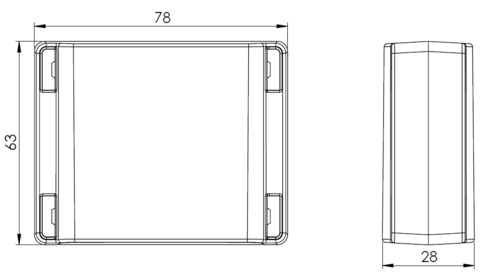TAT140 General description
TAT140 is a device for asset tracking and additional protection against thefts of valuable goods, as well as it could be used in wide range of applications from tools tracking to container tracking. It is a robust waterproof solution with extremely easy mounting. The usage of the battery mainly depends on how long you want to monitor your goods.
Package Contents
TAT140 device is supplied to the customer in a cardboard box.
Basic characteristics
GSM / GPRS / GNSS features:
- Teltonika TM2500 with Quectel EG915U-EU or Quectel EG915U-LA
- LTE Cat 1/GSM/GPRS/GNSS/BLUETOOTH® wireless technology
- GPRS Multi-Slot Class 12 (up to 85.6 kbps);
- Up to -165 dBm GNSS receiver sensitivity;
- SMS (text, data).
2G bands:
- TAT140-QJIBO: EG915U-EU GSM: B2/B3/B5/B8;
- TAT140-QKIB0: EG915U-LA GSM: B2/B3/B5/B8
4G LTE Cat 1 bands:
- TAT140-QJIBO: EG915U-EU LTE-FDD: B1/B3/B5/B7/B8/B20/B28;
- TAT140-QKIB0: EG915U-LA LTE-FDD: B2/B3/B4/B5/B7/B8/B28/B66
Data transfer:
- LTE: LTE FDD : Max 10Mbps (DL)/Max 5Mbps (UL)
- GSM: GPRS: Max 85.6Kbps (DL)/Max 85.6Kbps (UL)
Hardware features:
- Built-in movement sensor;
- Built-in Ultra-low-power Bluetooth® BlueNRG-232;
- Internal High Gain GNSS antenna;
- Internal High Gain GSM antenna;
- 128 MB Flash (220‘000 records);
- 2200 mAh extremely low self-discharge Li-SOCl2 batteries 7.2V.
Special features:
- Water and dust resistant for outdoor integrations;
- Magnetic mount, strap and additional holder mounting possibilities;
- Convenient OTA (over-the-air) updating through user-friendly applications;
- I/O event;
- Sending acquired data via GPRS;
- GPRS and SMS I/O events;
- Configurable using Secured SMS Commands;
- Accelerometer wake up;
- Bluetooth® sensor support; *
Recovery mode; Periodic tracking on stop / on move;
- Scheduler with time zones;
- Backup tracking;
- Static navigation;
- Lost BLE sensor
Technical features
| Part name | Physical specification |
|---|---|
| Status indication | 1 LED |
| USB | USB socket |
| Measurements | 78 x 63 x 28 mm (L x W x H) |
| LED State | Status |
|---|---|
| LED turned ON | Modem frozen or crashed unexpectedly |
| LED turned OFF | Device is in sleep mode or turned off |
| LED blinking every 5 seconds | Device is working, modem turned on |
| Technical details | |
|---|---|
| Operating temperature (without battery) | -20 °C to +60 °C |
| Ingress Protection Rating | IP68 |
Dimension drawing:

Technical information about internal battery
| Internal back-up battery | Battery voltage (V) | Nominal capacity (mAh) | Power (Wh) | Operating temperature range (°C) |
|---|---|---|---|---|
| Extremely low self-discharge Li-SOCl2 swappable, non-rechargeable battery, 7,2V 2200mAh | 7.2 | 2200 | 15.84 | - |
Li-SOCl2 Batteries and passivation effects
1. Introduction to Li-SOCl2 Batteries
Lithium-Thionyl Chloride (Li-SOCl2) batteries are widely used in IoT applications due to their high energy density, long shelf life, and ability to operate in extreme temperatures. Their stable output voltage makes them ideal for long-term deployments in remote or low-maintenance devices like smart meters, industrial sensors, and tracking systems.
2. Understanding Passivation: Pros & Cons
One characteristic of Li-SOCl2 batteries is passivation, where a thin lithium chloride (LiCl) layer forms on the lithium anode.
Benefits of Passivation:
- Reduces self-discharge, ensuring long-term energy retention.
- Extends shelf life, making these batteries reliable for long storage periods.
Drawbacks of Passivation:
- Can cause voltage delay when the battery is first used after storage.
- High initial resistance may result in a temporary voltage drop, especially in high-drain applications.
3. Issues After Long Storage & Voltage Drop
If a Li-SOCl2 battery has been stored for an extended period, the passivation layer can become thicker, leading to:
- Lower initial output voltage when first used.
- A brief period where the device may not receive full power.
In IoT applications, this means sensors or communication modules might experience startup issues after long inactivity.
4. What to Do After Long Storage
For devices using these batteries, if a low voltage is detected after a long storage period, a simple solution is to send a record to the server. This brief activity will help break down the passivation layer, and the battery output voltage will automatically rise back to normal within approximately 24 hours.
This approach ensures reliable operation without manual intervention, making Li-SOCl₂ batteries a practical choice for IoT and long-life industrial applications.

